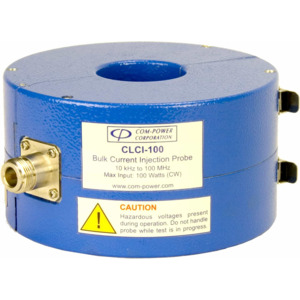
- Description
- Attributes
- Documents
The CLCI-100 Bulk Current Injection Probe is part of ComPower's extensive line of radio frequency conducted immunity test equipment and calibration accessories; geared specifically to comply with the requirements contained in IEC 61000-4-6 and CISPR 16-1-2.
The CLCI-100 incorporates split-core ferrites into its rugged, circular enclosure, and is hinged; thereby allowing the probe to be opened on one side in order to easily place the wire, cable(s) or cable bundle(s) to be tested into the probe window, making the CLCI-100 much more convenient to use than other non-split core probes.
The efficiency of the CLCI-100 probe enables it to achieve test levels up to 10 Vrms across its frequency band with less than 100 watts forward power. The probe can handle up to 100 amps "window current" on its secondary, and up to 100 watts RF input power to its primary.
An RF Current probe is typically used in conjunction with spectrum analyzer or EMI receiver, which measure magnitude quantities in terms of true rms voltage. The Transfer Impedance conversion factor, which is expressed in terms of dB over 1Ω, converts the voltage quantity into a current quantity, expressed in terms of dB over 1 uA.
The conversion factor may also be derived from the Transfer Admittance value, expressed in terms of dB over 1 S.
As is the case with nearly all Com-Power products, individual NIST traceable calibration is performed on each unit, and the data is provided along with certificate of calibration. ISO 17025 accredited calibration is available for an additional charge.
Application
In general, RF current probes are employed either to monitor, or measure, the RF current flow on a wire, cable or cable bundle; or to do the opposite, inject RF energy onto a wire, cable, or cable bundle. The current is measured (or injected) inductively by clamping the probe around the line(s) to be tested. No actual contact is made with the conductor(s), and the insulation is left in place. Essentially, a current probe is a torroidal transformer. When used to inject current, the probe is the primary, and the line(s) under test act as the secondary. When used as a measuring device, the roles are, of course, reversed.
Current probes are calibrated through the use of a calibration fixture with a coaxial-type arrangement. The fixture allows the probe to be clamped around the center conductor, while the outer conductor encapsulates the probe on four sides, so that the transmission line characteristics are not compromised. See calibration fixture picture on the following page.
The CLCI-100 Bulk Current Injection Probe is designed to be compatible with the Com-Power FCLC-100 Calibration Fixture, which is available separately. The fixture is required for calibration of the insertion loss/conversion factor, transmission loss & VSWR parameters, as well as for setting the amplitude of the injected RF to the appropriate test level (i.e.: 3 Vrms, 10 Vrms, etc.) over the frequency range of the test.
Per IEC 61000-4-6, an injection clamp should be used only when there is no commercially available CDN for the type of port(s) to be tested. Unlike the CDN, a clamp does not provide the decoupling functions or establish the required impedance. Therefore, the flow of current is not controlled, and a current monitoring probe must also be installed on the line(s) under test to ensure that the current does not exceed the maximum required current.
